Glimpses of Meridian, Mississippi |
TrainsPart 7 |
Amtrak 40th Anniversary Train |
| Since starting service May first, 1971 Amtrak has grown so that today it's passenger service covers 21,000 miles of track - connecting 500 destinations in 46 states and three Canadian provinces. In celebration of that 40 years - Amtrak put together a display train that started touring the country in the spring of 2011 - beginning at their National Headquarters at Washington D. C. (May 7th); then on through Virginia, Maryland, Pensylvania, Masachuesets, Connecticut, Rhode Island, Maine, Vermont, New York, Misouri, Illinois, Michigan, Wisconsin, Washington, Oregon, California, Texas, Oklahoma, New Orleans and finally today Februrary 4 (and 5th): in Meridian. Meridian's importance to Amtrak is noted in the fact that while Amtrak operates in 46 States - only 21 states (plus the District of Columbia) were selected as display sites - and the only small city - among those selected was Meridian. Alabama, Georgia, Tennessee, Arkansas, nor Kentucky - all states in which Amtrak operates - were chosen as a display site. Another telling factor is that Meridian is by far the smallest city of any to receive a two-day display stop. After the display closes Sunday afternoon - the train will travel to it's last two stops - both in Florida. |
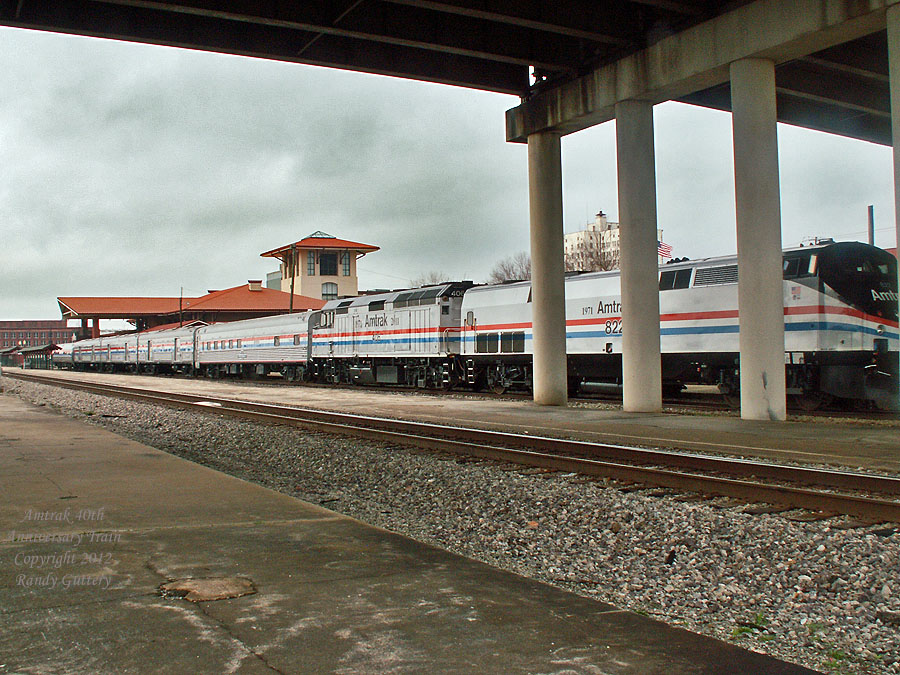 |
| Amtrak's 40th Anniversary Train at Union Station, Meridian, Mississippi February 4th 2012 |
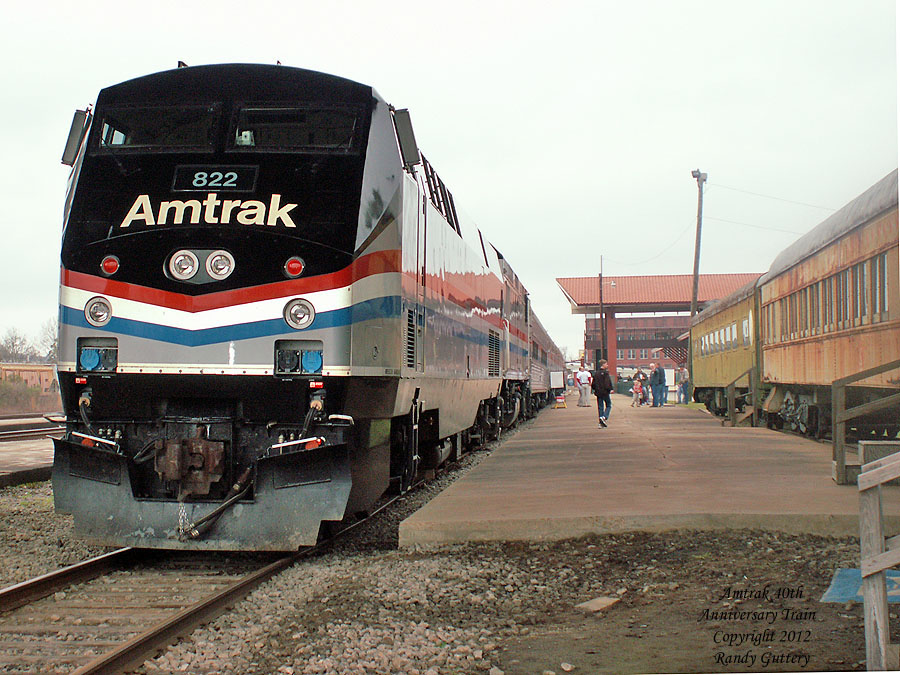 |
| Some of the early visitors getting a good look at the various displays. The Queen and Crescent Chapter of the National Railway Historical Society had their museum open for visitors as well. |
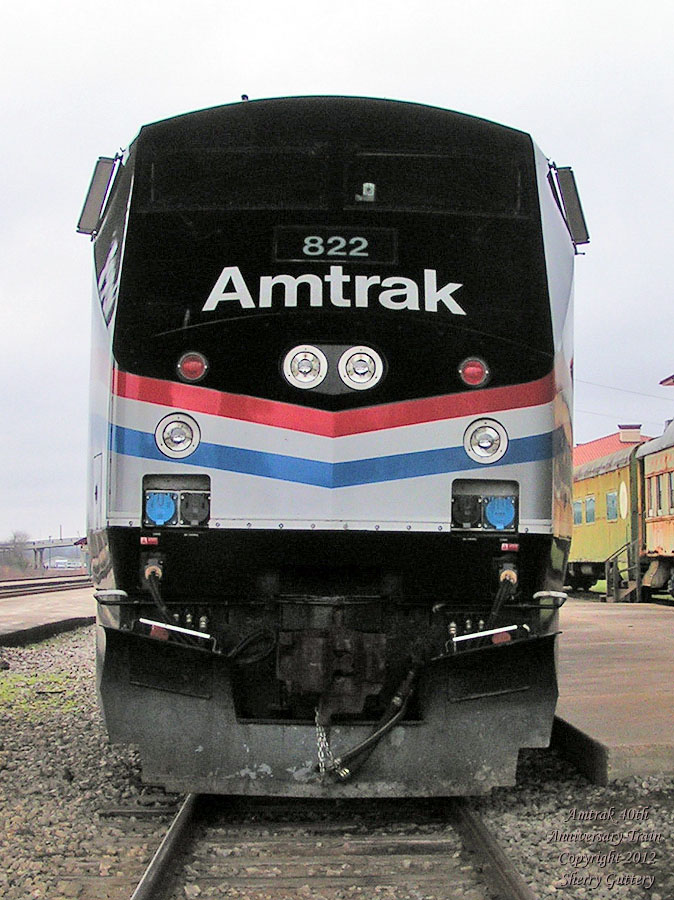 |
| "Toe-to-toe" with a mighty GE P40DC locomotive #822. Built for Amtrak in 1993 by General Electric in Erie, Pa., this (originally) 4,000 horse power locomotive provides the pulling power for the Exhibit Train. It was originally based in New Orleans and operated on various long distance routes (including the Crescent - running through Meridian). The 822 was later reassigned to Albany, N.Y. and operated in the northeast until stored as surplus in 2003. It was selected as one of the 15 P40 locomotives to be upgraded and returned to service as part of the American Recovery and Reinvestment Act of 2009. The upgrades that have been made include upgading the horse power produced to 4250 (and increasing the top speed to 110MHP); as well as a state of the art cab signaling system. |
|
|
 |
| Another view of Amtrak 822 Once 822's task of pulling the Anniversary Train is completed - it will again become a passenger locomotive somewhere on Amtrak's routes. |
|
|
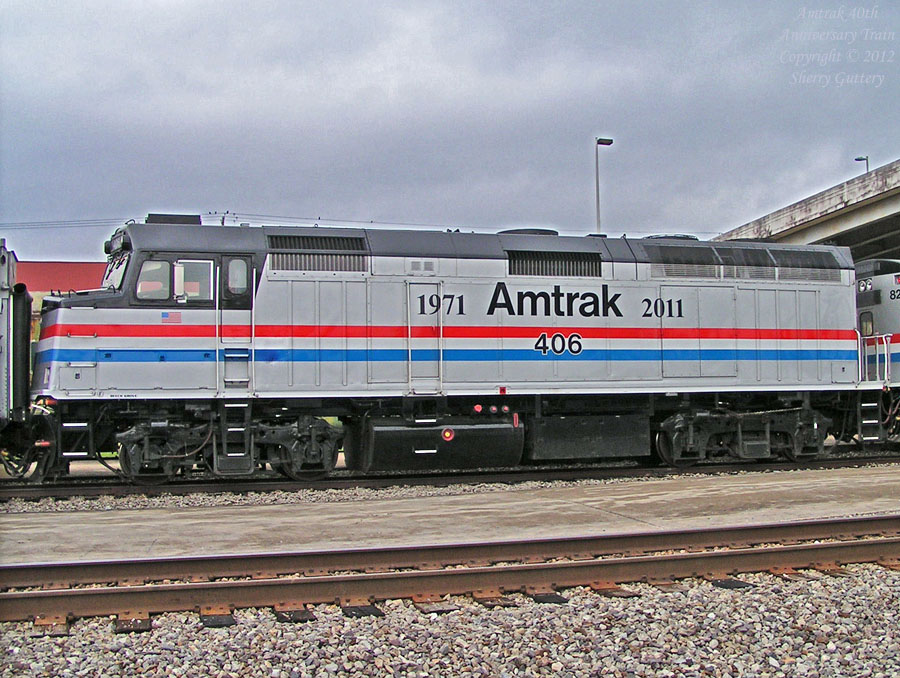 |
| Representing an older time with both Amtrak - and American railroading in general - is this former EMD F40 locomotive. Built for Amtrak in July 1988 by EMD as a 3,000 horse power F40PH locomotive number #406, was rebuilt as Non Powered Control Unit #406 in 2011 at the Beech Grove, Ind., maintenance facility. As a locomotive, the 406 operated all over the country on various routes before being stored in 2001. It was slated to become an NPCU to augment the push-pull fleet, and chosen to be part of the Exhibit Train because it can control a locomotive without the expense of additional fuel, allowing a train to operate in either direction without turning around. It will also provide Head End Power (HEP) to power the lights and HVAC systems onboard the train. |
|
|
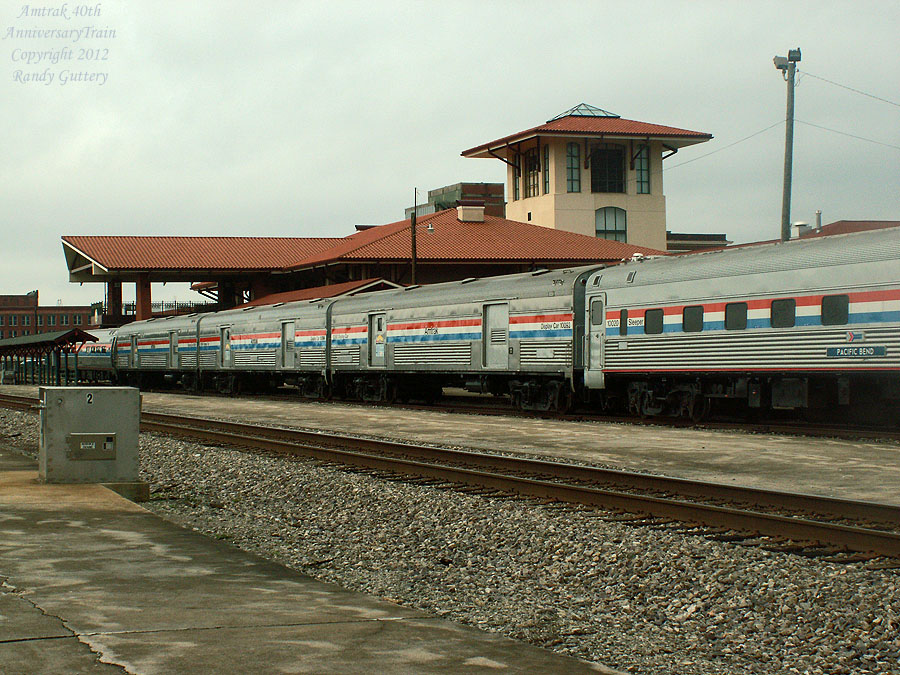 |
| The Anniversary Train consist (in railroad parlance - "consist" is the term used for the rolling stock of the train - not including the locomotives). |
|
|
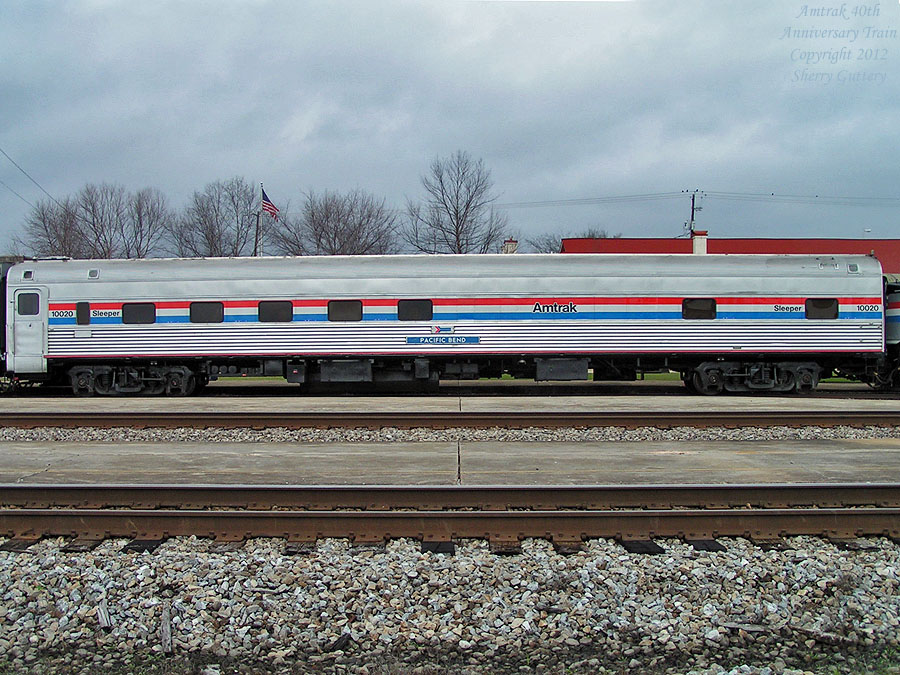 |
| First is the "Pacifc Bend" sleeper car 10020. Built in 1950 by the Budd Company for the Union Pacific as Sleeper #1404 and named, “Pacific Bend.” It contained 10 roomettes and 6 double-bedrooms, and joined the Amtrak fleet in 1971 as Sleeper #2603. The car was upgraded from steam heat to Head End Power (HEP) in 1977 and renumbered 2903. In 1997, the car was converted for service as a crew dormitory for use on eastern long distance trains, and renumbered 2504. Stored in 2006, the car remained inactive until 2007, when it was modified for use by the Amtrak Police Department as a Special Communications Car. It was renumbered 10020 and renamed “Pacific Command” at that time. The original name, “Pacific Bend,” has since been reapplied and the car will serve as a Sleeper for Amtrak staff during the 40th Anniversary Exhibit Train’s tour. |
|
|
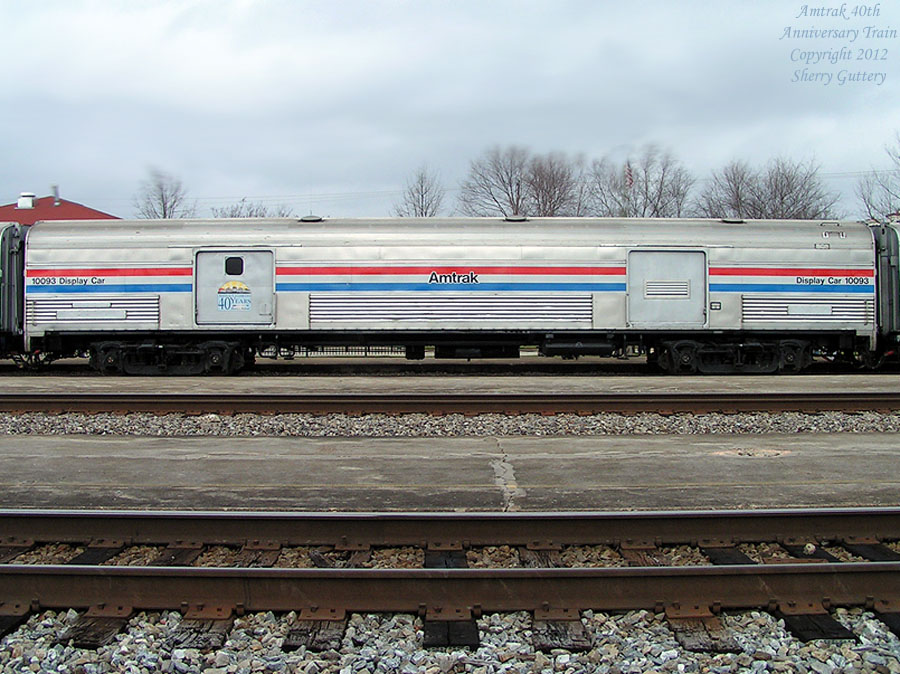 |
| Display Car 10093, built in 1953 by the Budd Company as Baggage car #3535 for the ATSF and transferred to Amtrak fleet in 1971, when it was renumbered 1049. In 1978 it was upgraded from steam heat to Head End Power (HEP) and renumbered 1222. Needing repair and no longer fit for service, the car was stored in 2007 at Beech Grove until selected as one of the three 40th Anniversary Exhibit Train Display Cars. |
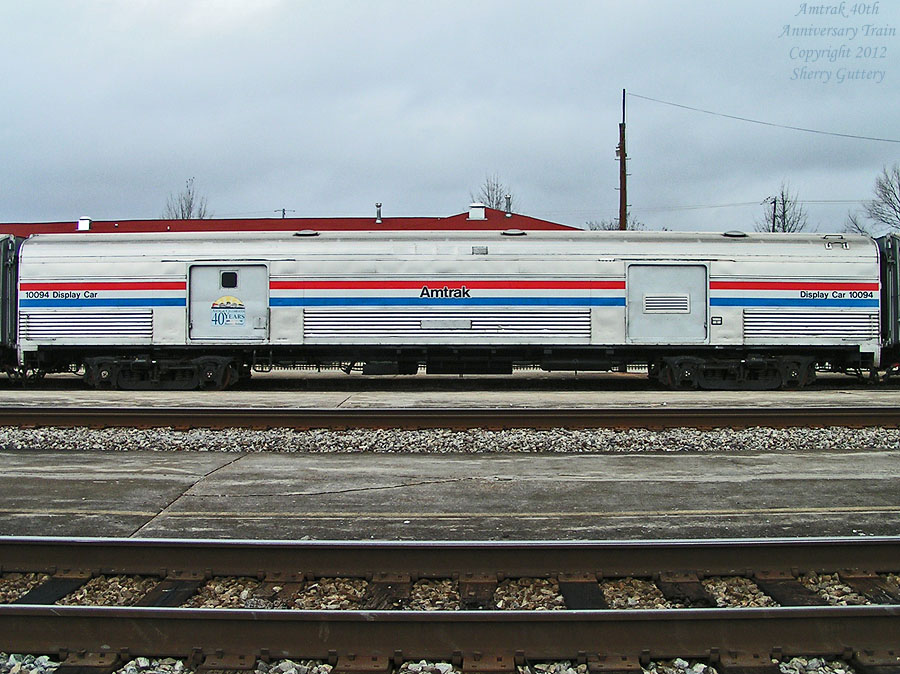 |
| Display Car 10094, built in 1957 by the Budd Company as Baggage car #3547 for the ATSF, this car became part of the Amtrak fleet in 1971 and was renumbered 1061. In 1978 it was upgraded from steam heat to Head End Power (HEP), and renumbered 1228. Needing heavy repair, the car was stored in 2009 at Beech Grove until selected as one of the three 40th Anniversary Exhibit Train Display Cars. |
 |
| Display Car 10095, built in 1953 by the Budd Company, started life as Baggage car #3512 for the Atchison, Topeka & Santa Fe (ATSF) Railroad. After transfer to Amtrak in 1971, it was renumbered as 1029, upgraded in 1978 from steam heat to Head End Power (HEP) and renumbered 1219. In 2000, this car was one of three baggage cars rebuilt with bicycle racks for use on the Twilight Shoreliner, and was renumbered 1856. In 2005, the car was stored at our Beech Grove, Ind., maintenance facility due to mechanical problems. Selected for use on the 40th Anniversary Exhibit Train, it was the first of the three Display Cars completed by our Beech Grove, Ind., maintenance facility. |
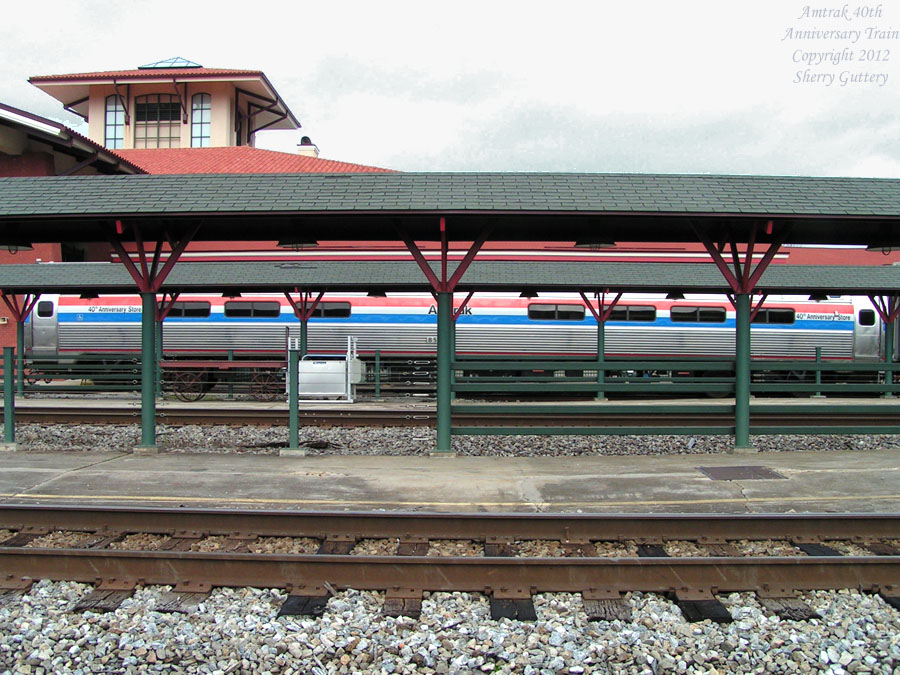 |
| 40th Anniversary Store 85999, built for Amtrak by the Budd Company in 1976 as Amclub #20130, which featured a “split club” configuration of 18 club seats at one end, 23 coach seats on the other. In 2000, the car was converted to Capstone Cafe car #85004 for use on the newly branded Acela Regional service. It was stored on July 31, 2005 due to an abundance of food service cars of this type in the fleet. It was selected to serve as a combination 40th Anniversary gift shop and display car for the Exhibit Train, with work being performed at the Bear, Del. and Beech Grove, Ind. maintenance facilities. |
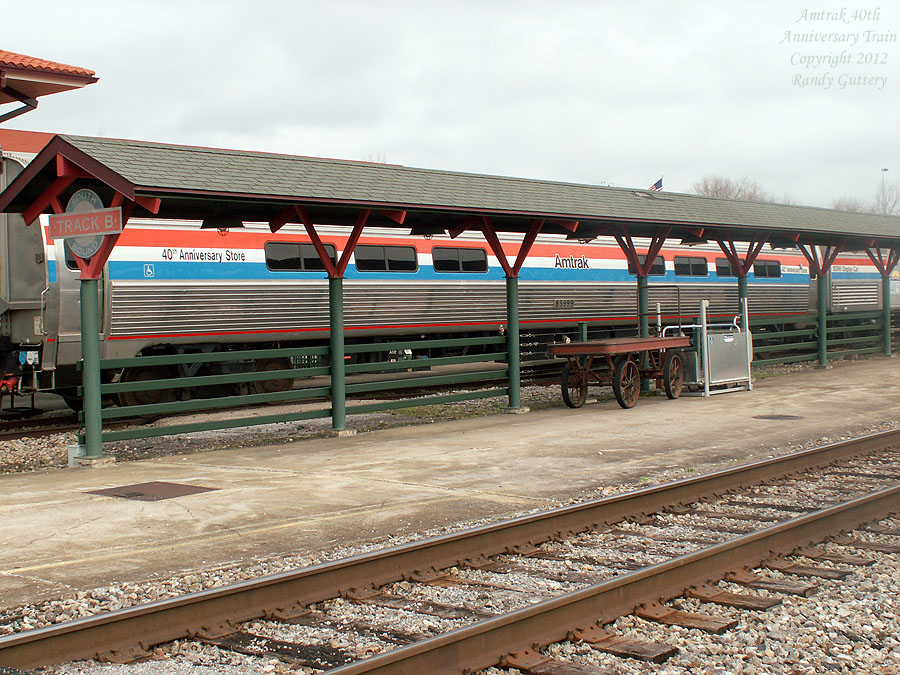 |
| Another view of 85999 |
|
|
 |
| Track-side view of the end of the Amtrak 40th Anniversary Train in front of Union Station, Meridian. |
 |
| Station side view of the Amtrak 40th Anniversary Train at Union Station, Meridian. |
 |
|
|
 |
| A volunteer with the Queen and Crescent Chapter of the National Railway Historical Society - and a representative of Amtrak welcome visitors aboard the 40th Anniversary Train. |
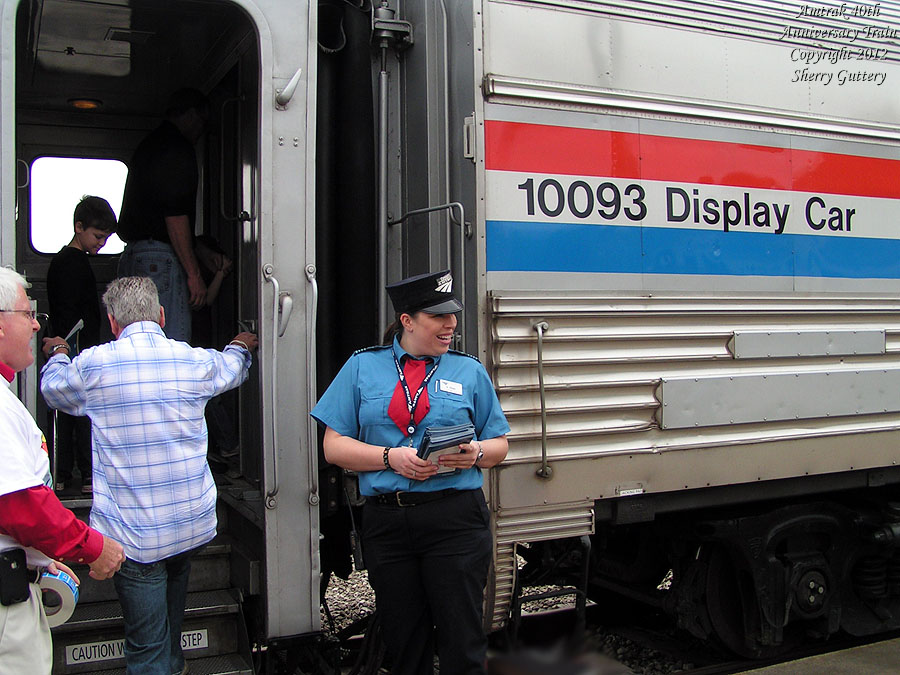 |
| Freindly faces waiting for the next group of visitors. They didn't have long to wait - as the crowds were large and steady all Saturday morning. |
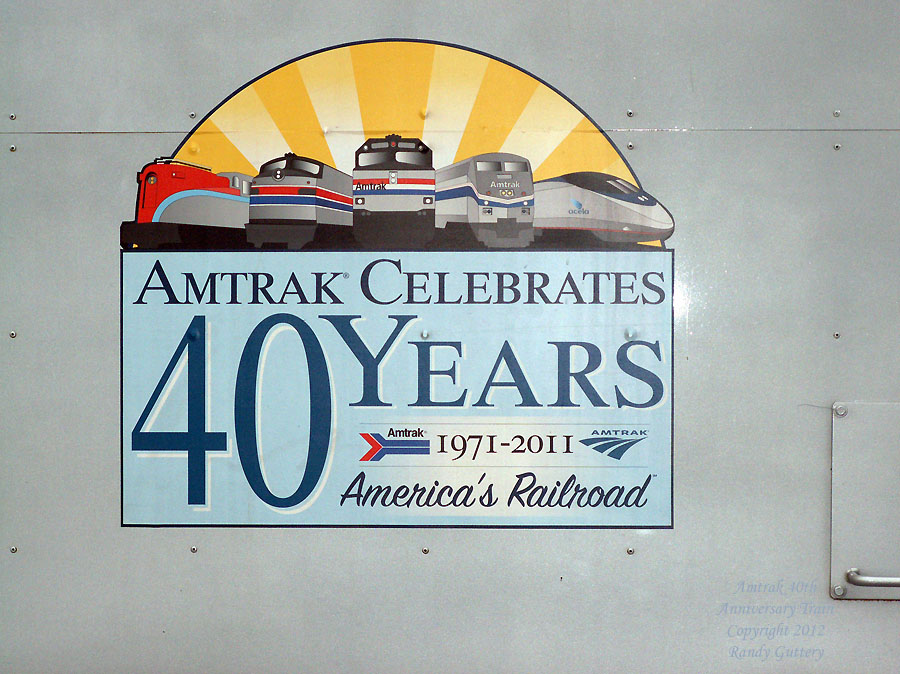 |
| Close-up of one of the display car placards... |
 |
| Start of the tour through the display cars... |
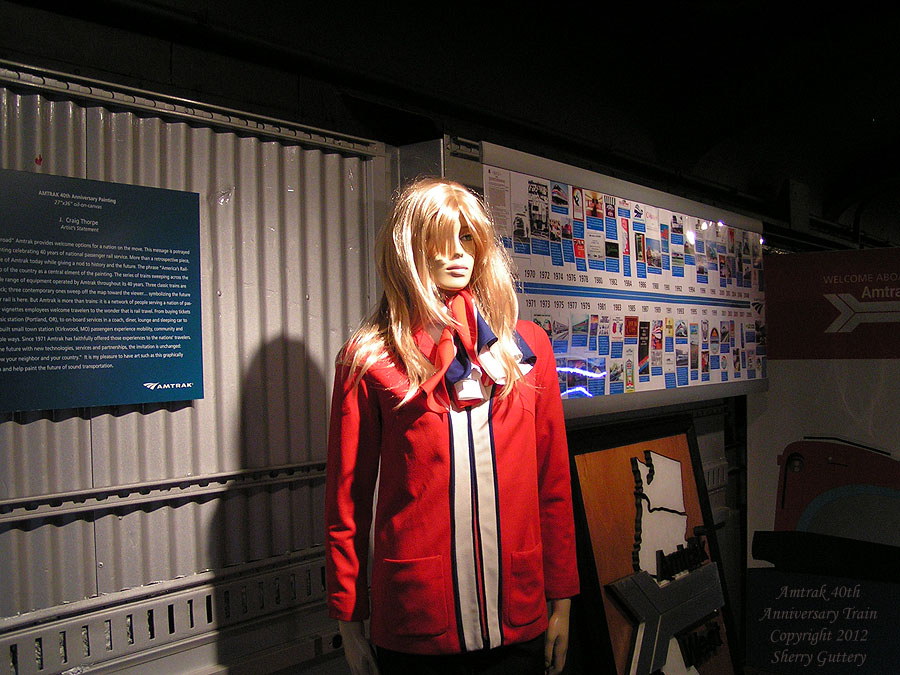 |
| There are many manikins throughout the displays modeling samples of Amtrak uniforms over the years. |
|
|
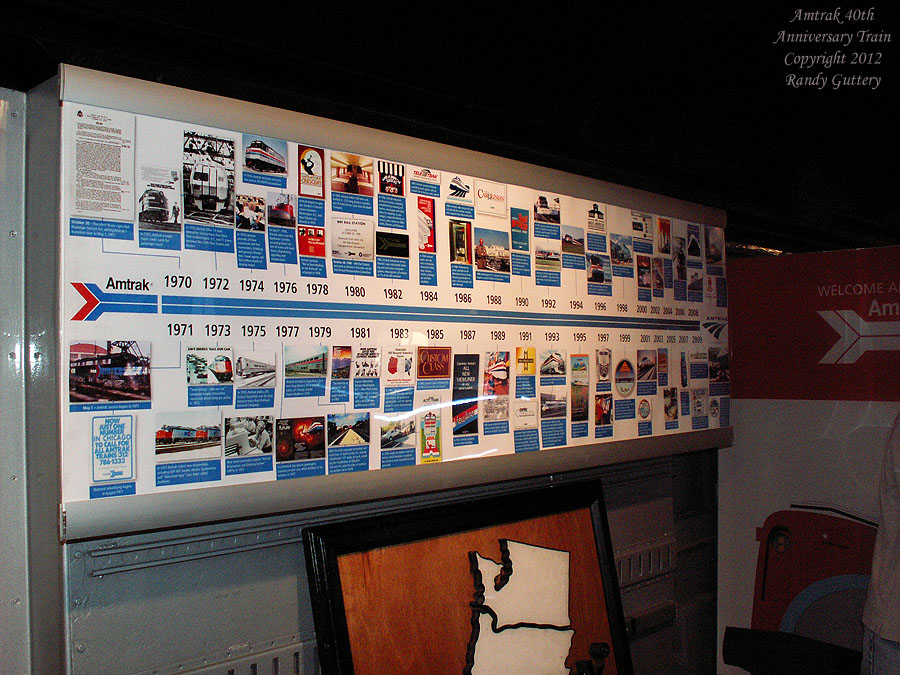 |
| Amtrak history timeline. |
|
|
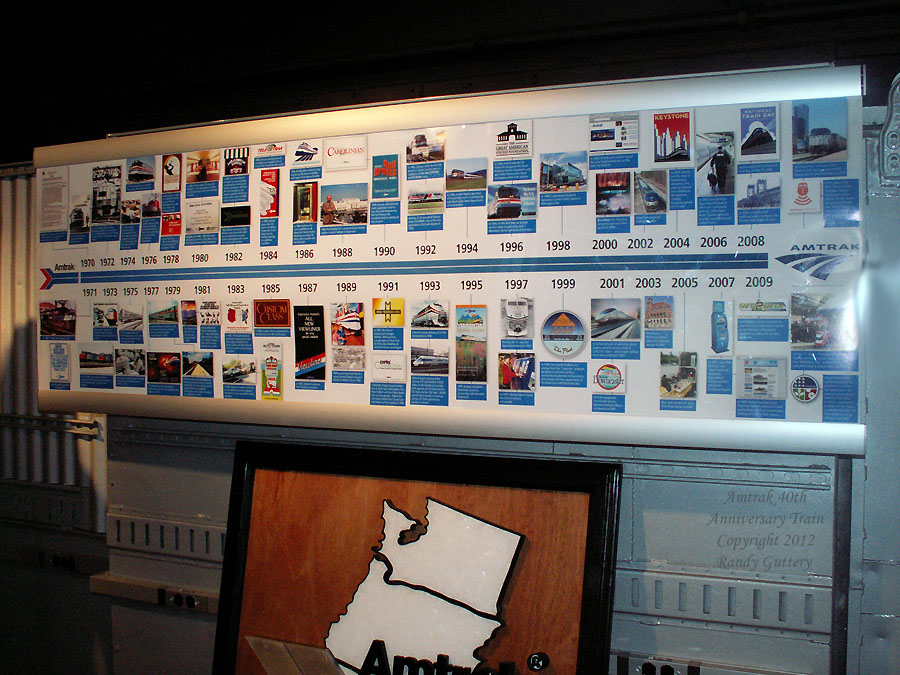 |
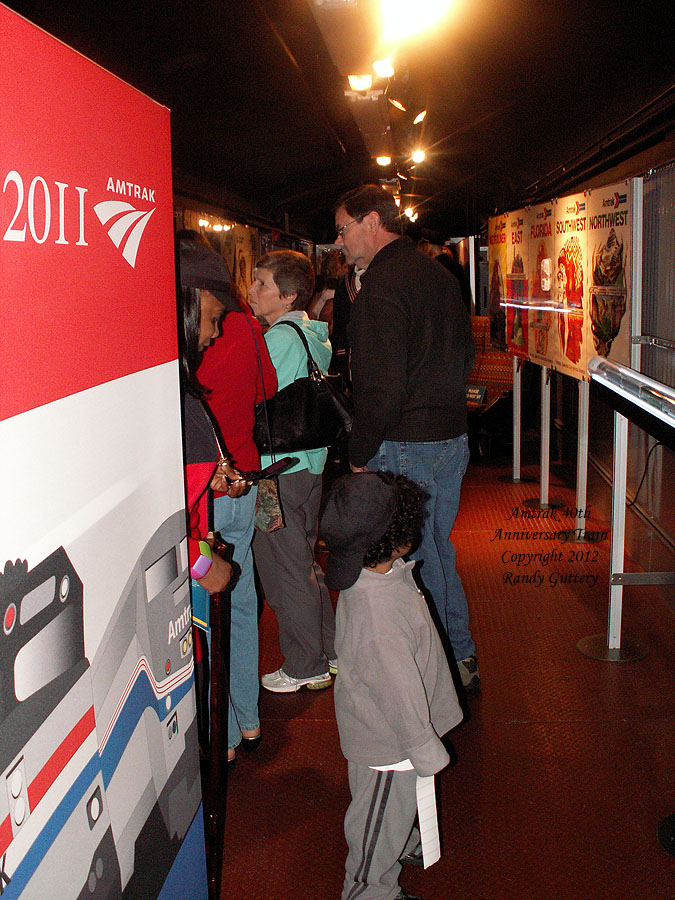 |
| Visitors examining one of the many displays. |
|
|
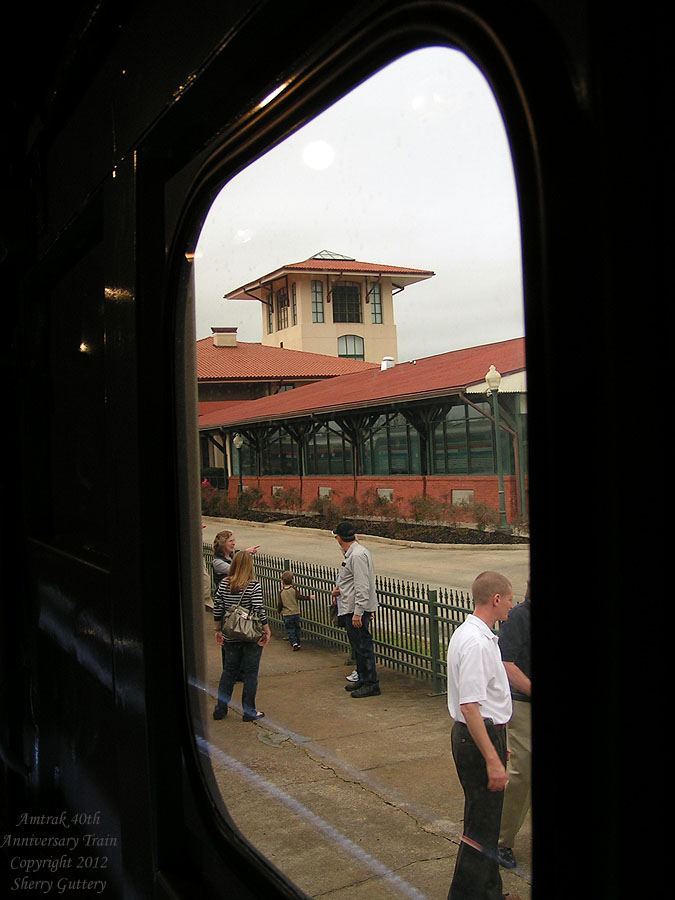 |
| Meridian's Union Station as seen from an Amtrak passenger seat. |
|
|
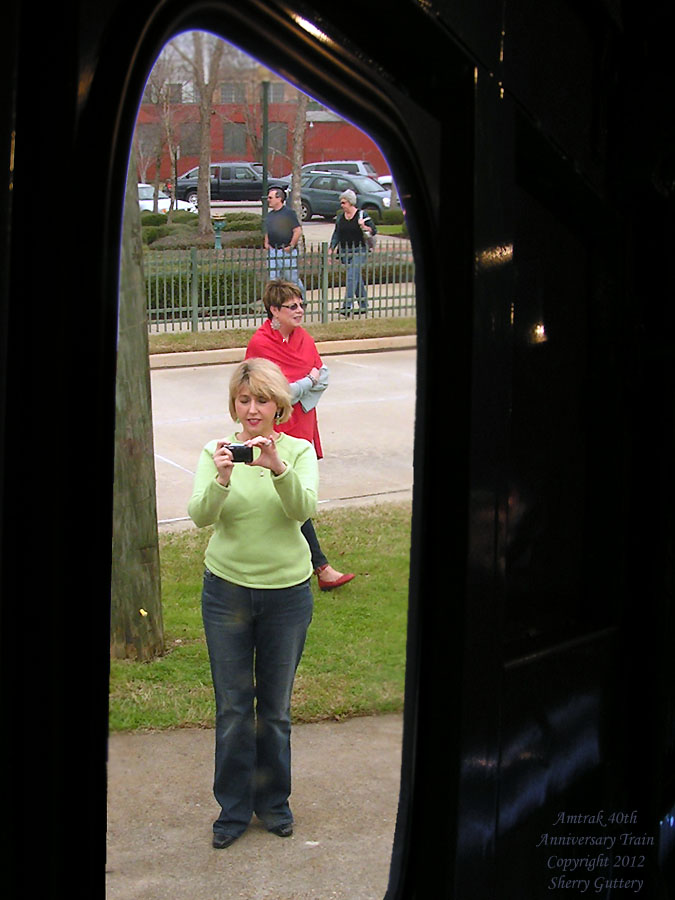 |
| While looking out the windows - Sherry spots a friend taking a picture of the train (she has no clue she's in Sherry's sights...) |
|
|
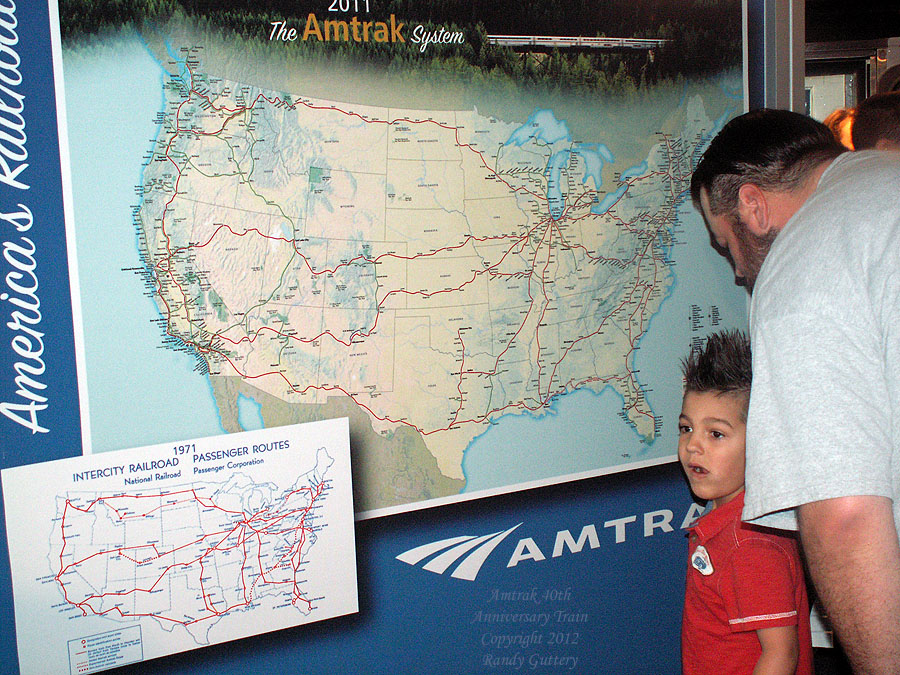 |
| Meanwhile - vistitors young and old discover neat things to look at and learn about... |
|
|
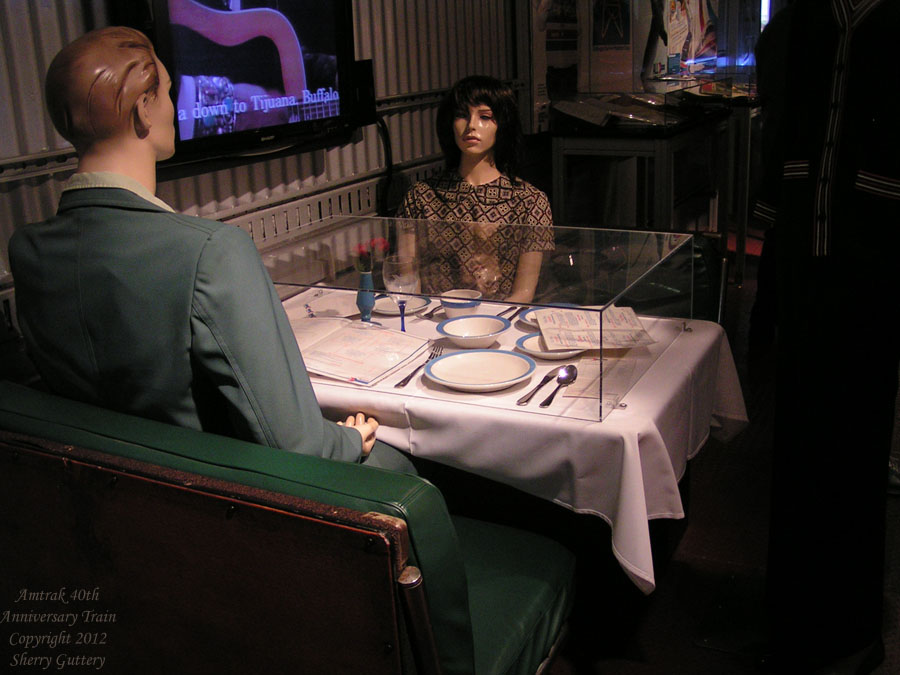 |
| Amtrak dining service... |
|
|
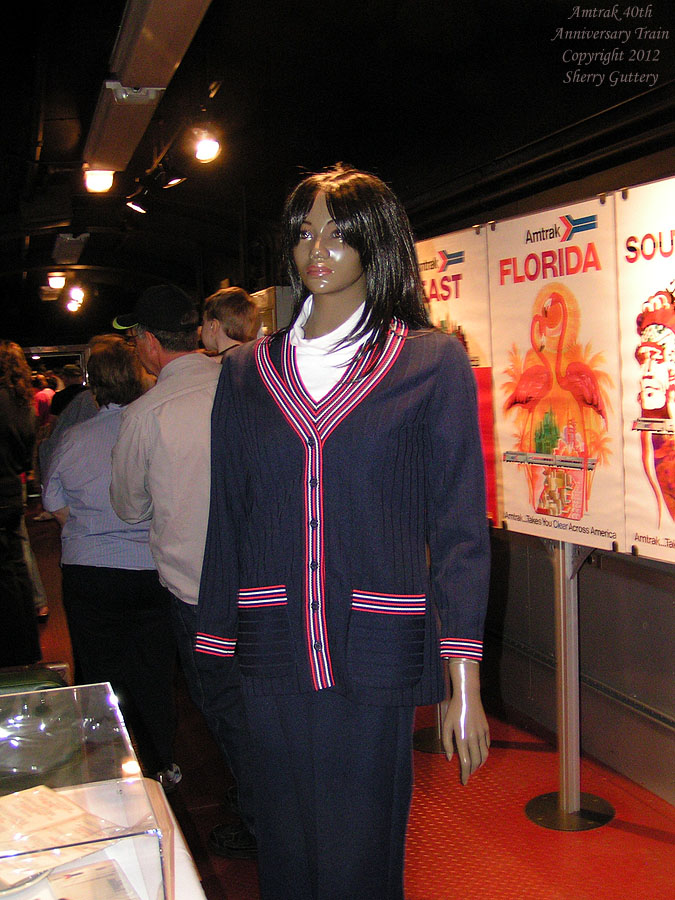 |
| Complete with server wearing a typical uniform from earlier days. |
|
|
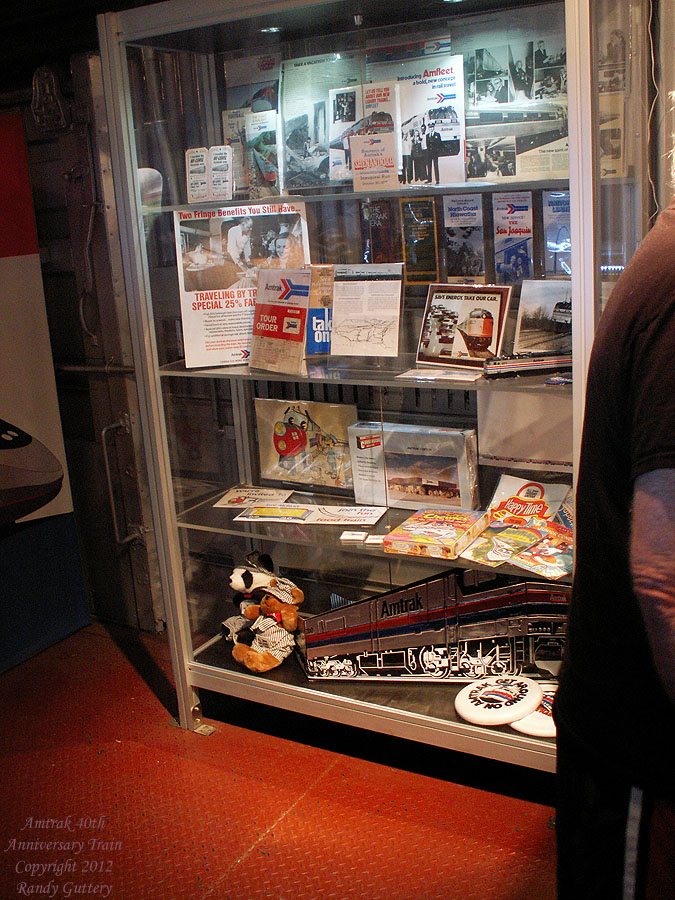 |
| One of many display cases of Amtrak memoribilia - this containing advertising and Amtrak related toys. |
|
|
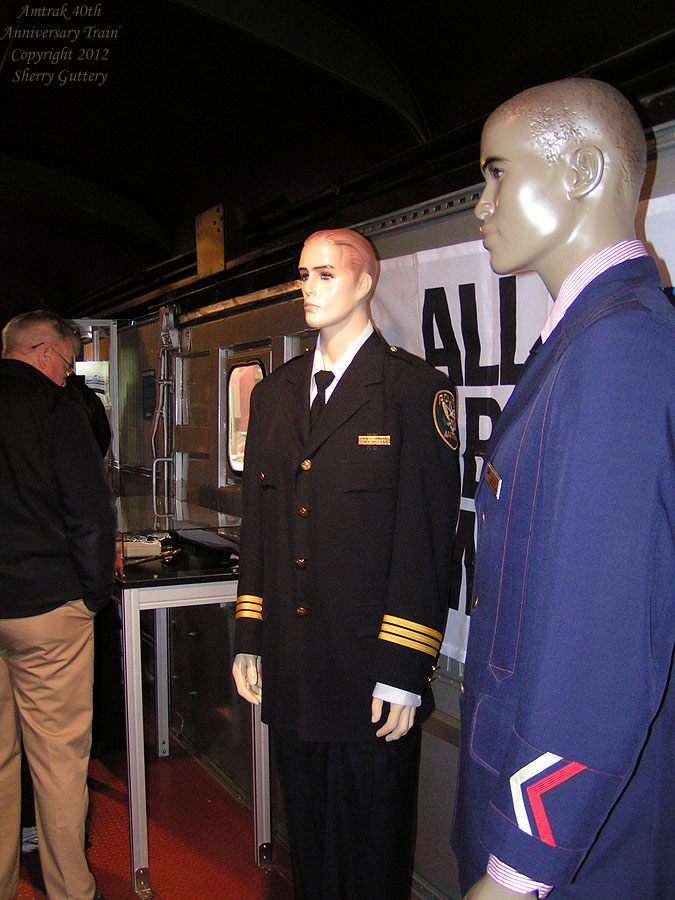 |
| More Amtrak uniforms -including Amtrak police on the left. |
|
|
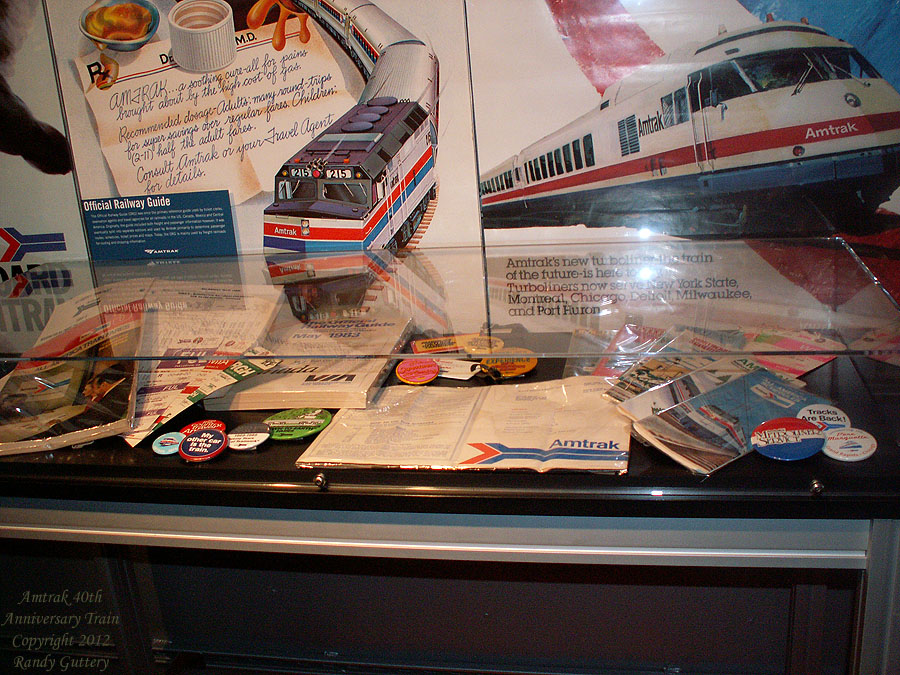 |
| Another memorabilia display. |
|
|
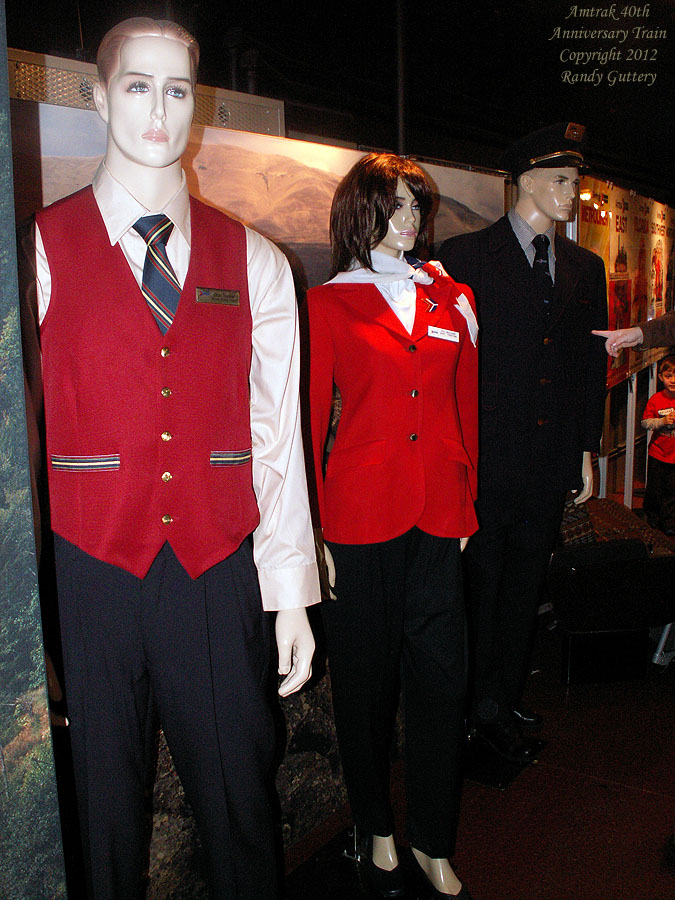 |
|
|
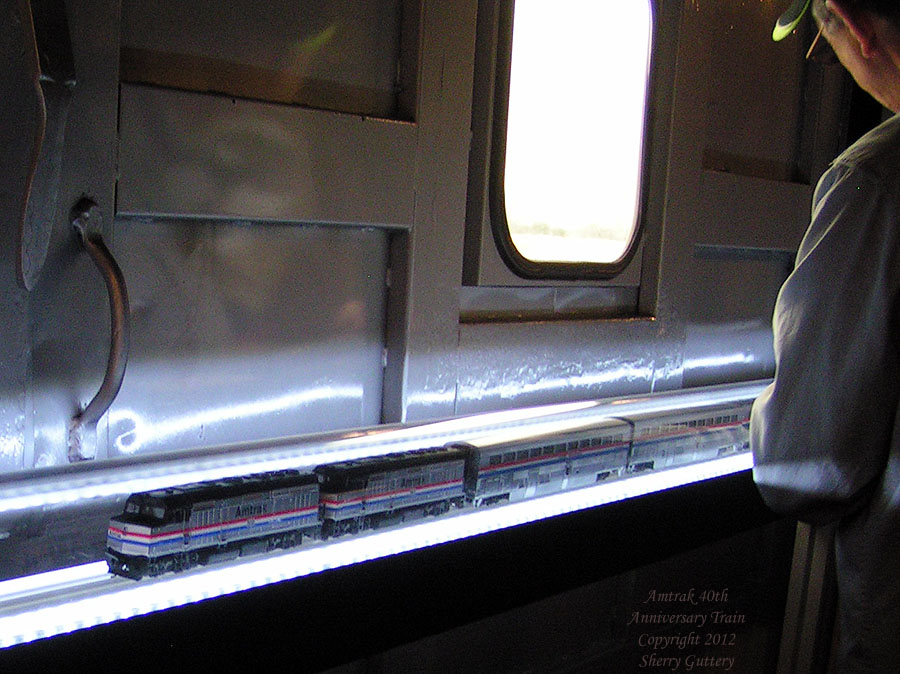 |
| One of several models depicting Amtrak power and rolling stock used during it's 40 year history. |
|
|
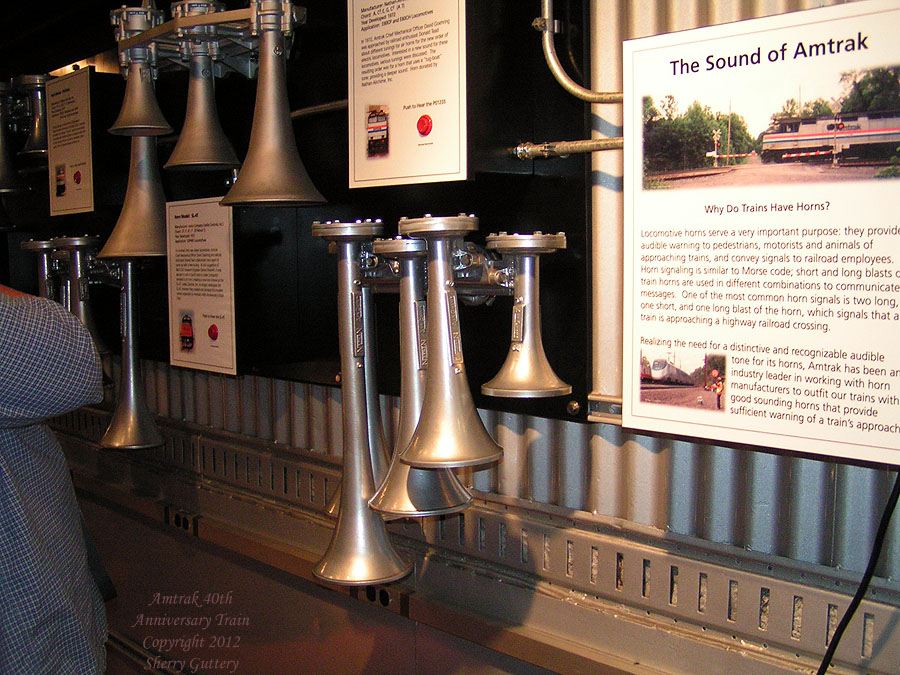 |
| An interacitve display of various horns used by Amtrak. By pushing a button near each set - one could hear a recording of that set. Having owned a set of Leslie 3R3s - we were delighted they didn't "honk" for real - you can not imagine how loud those things are close up! |
|
|
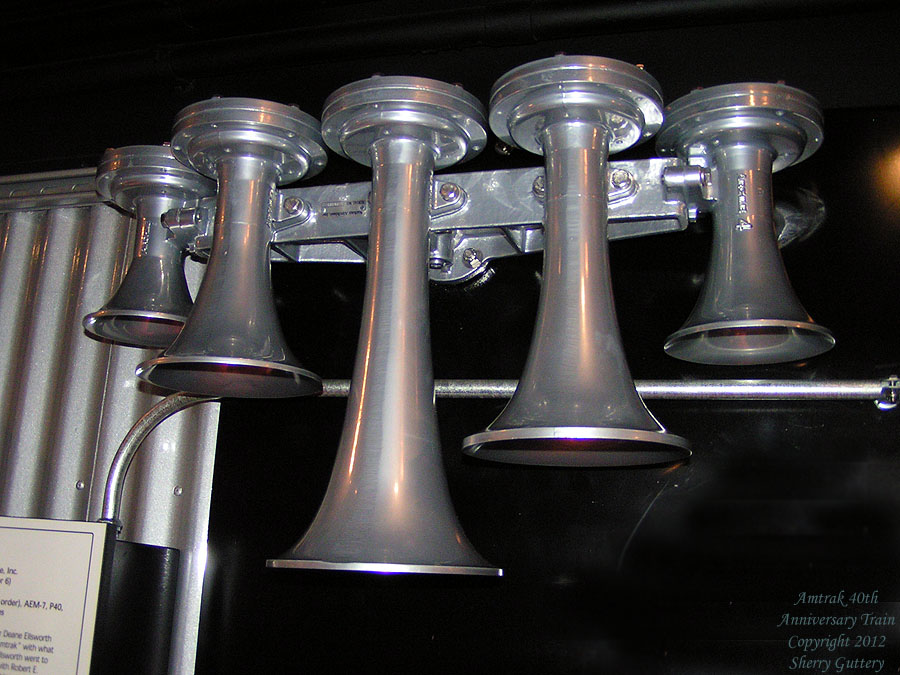 |
| Nathan K5LA horns - Used on most Amtrak (and many other) locomotives today - this is the typical "Amtrak sound" most people recognize. |
|
|
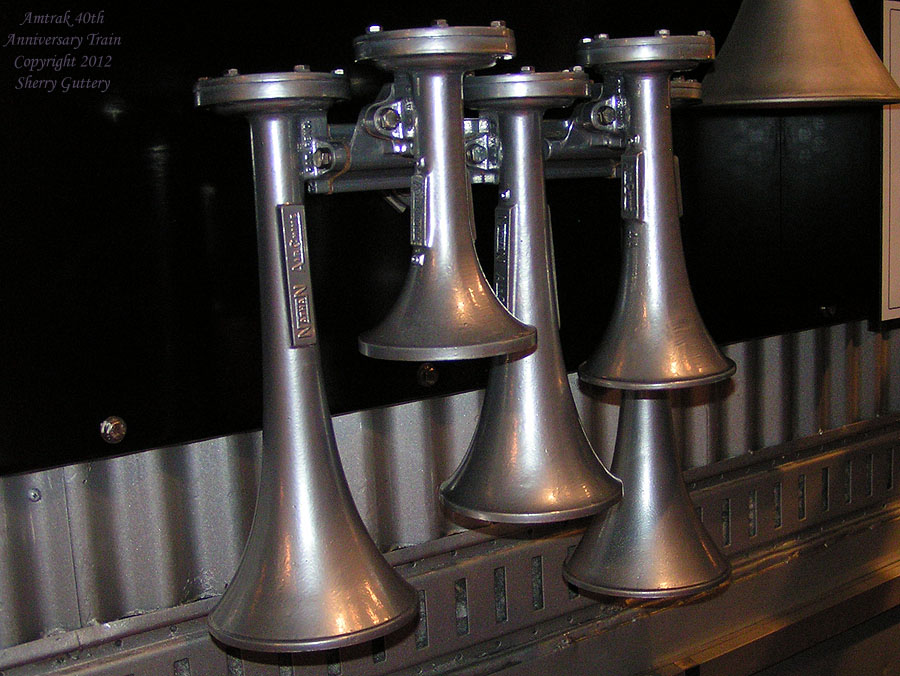 |
| A set of Nathan P1234A5 "Air Chimes" |
|
|
 |
|
|
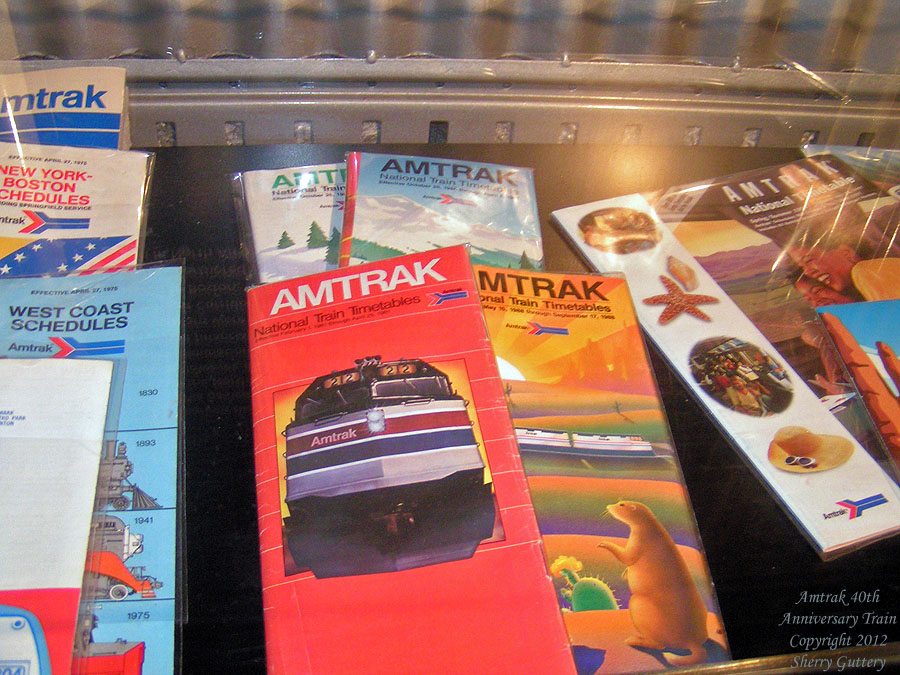 |
|
|
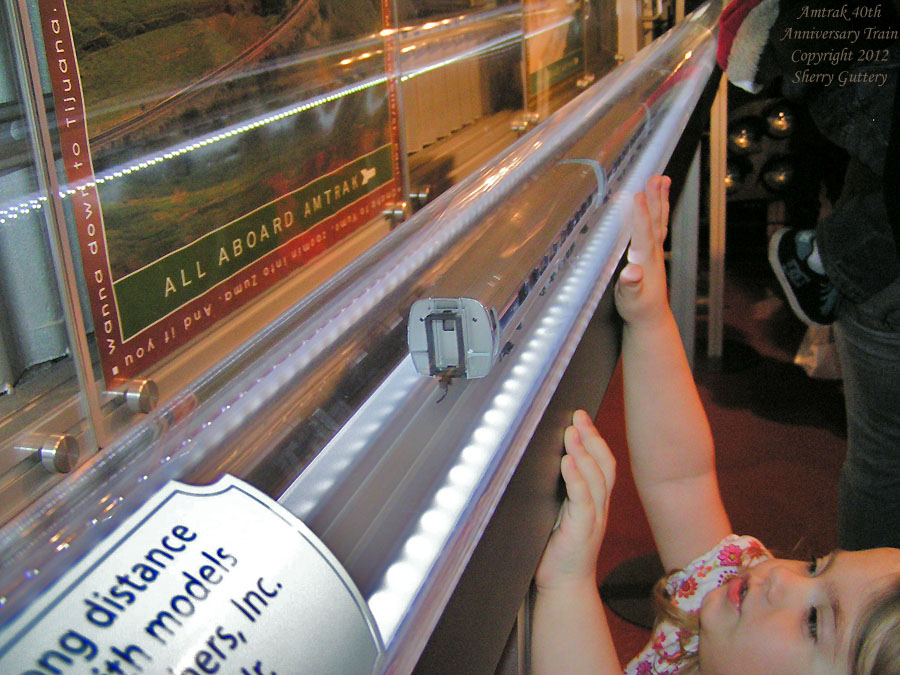 |
| Future Engineer? |
|
|
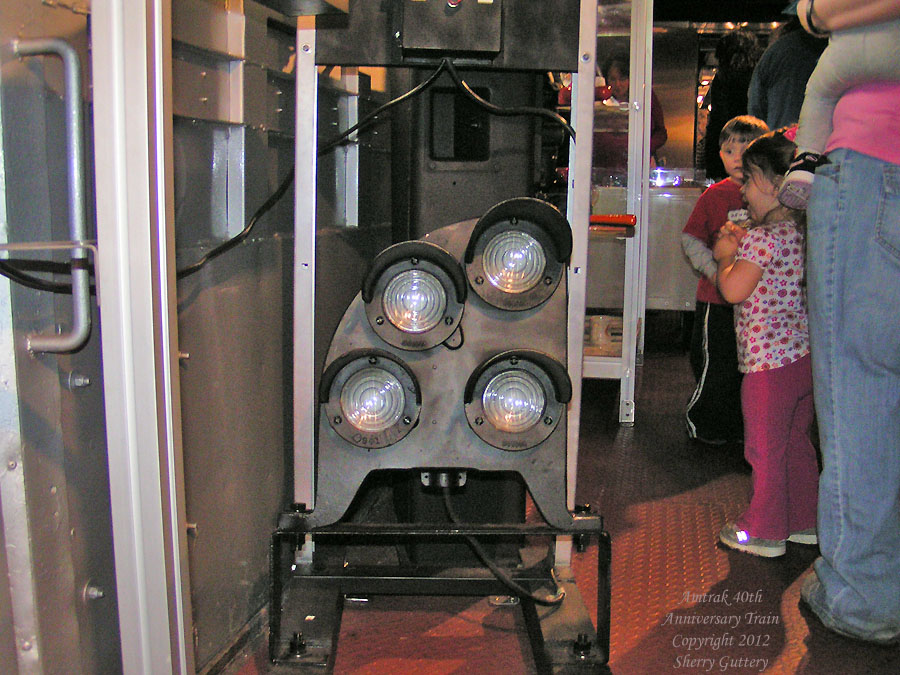 |
| Original track-side control signal from Amtrak's C & S repair shop yard. This Union Switch and Signal Model PL4 controlled trains moving through the yard (i.e. a slow speed area). |
|
|
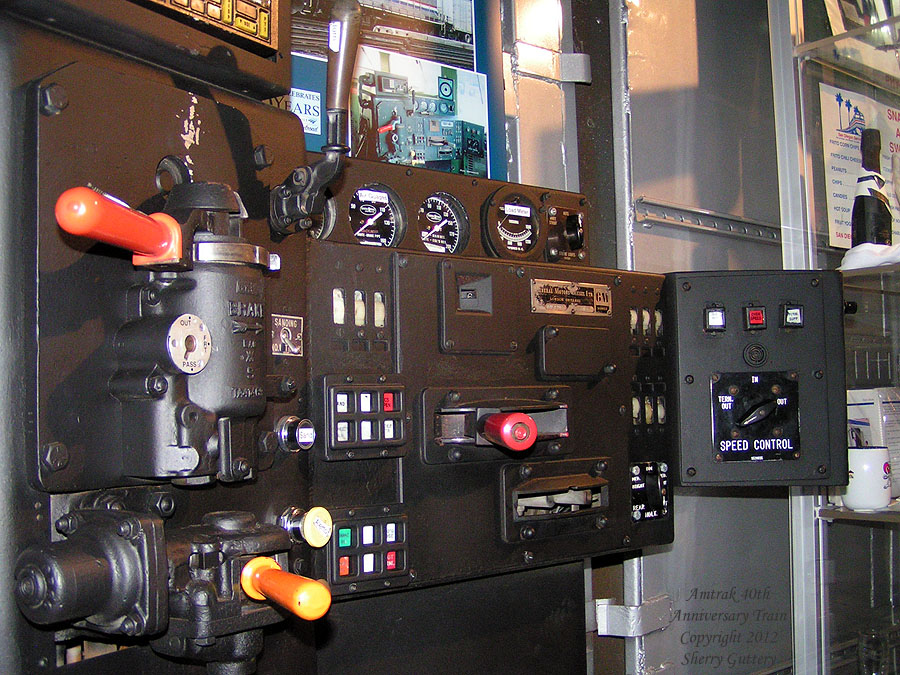 |
| Locomotive control stand from an EMD (General Motors) F40PH engine. |
|
|
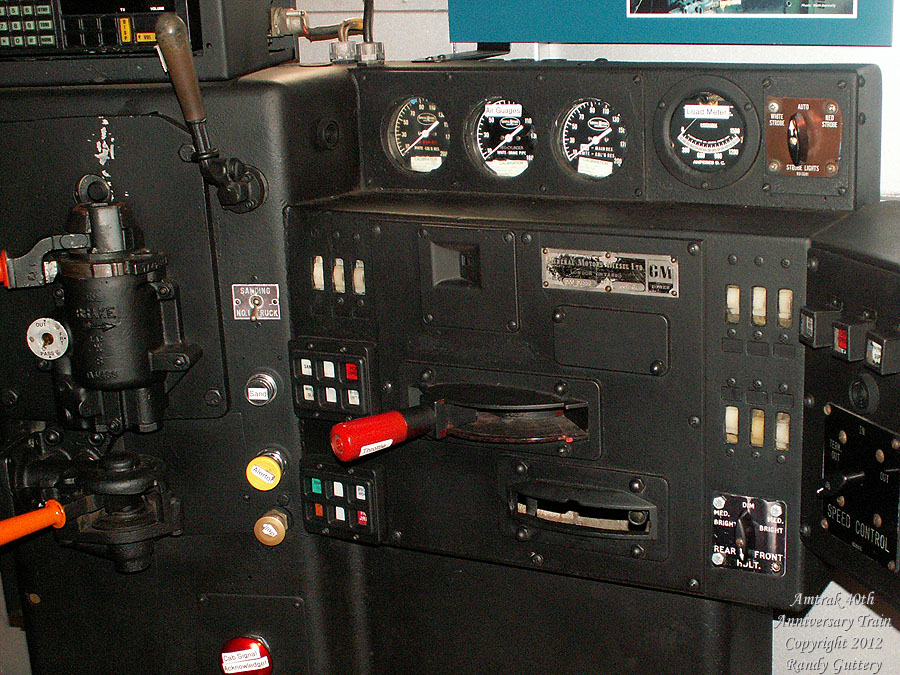 |
|
|
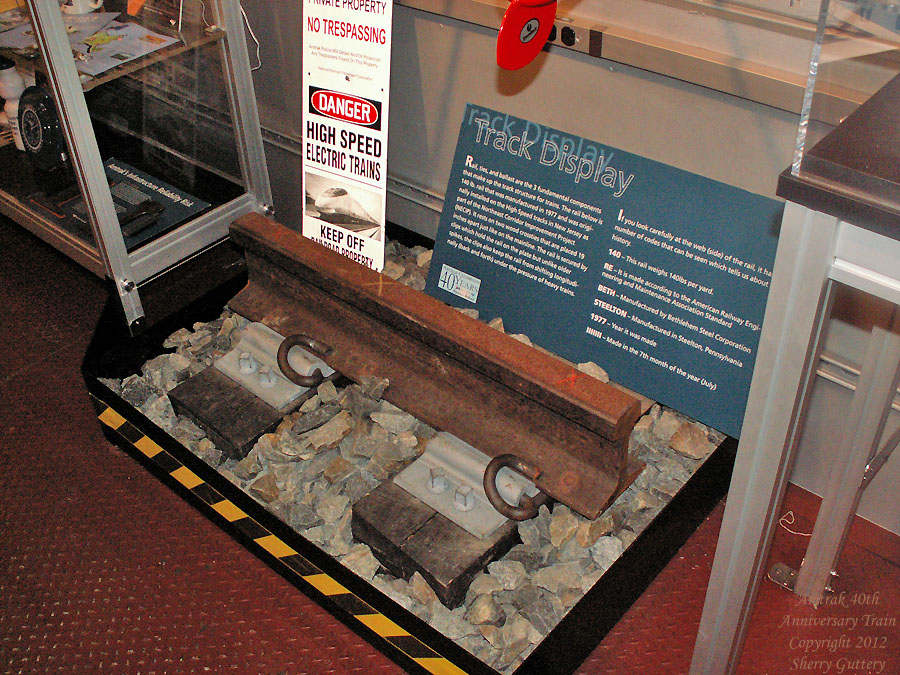 |
| Display of current Amtrak high speed track. |
|
|
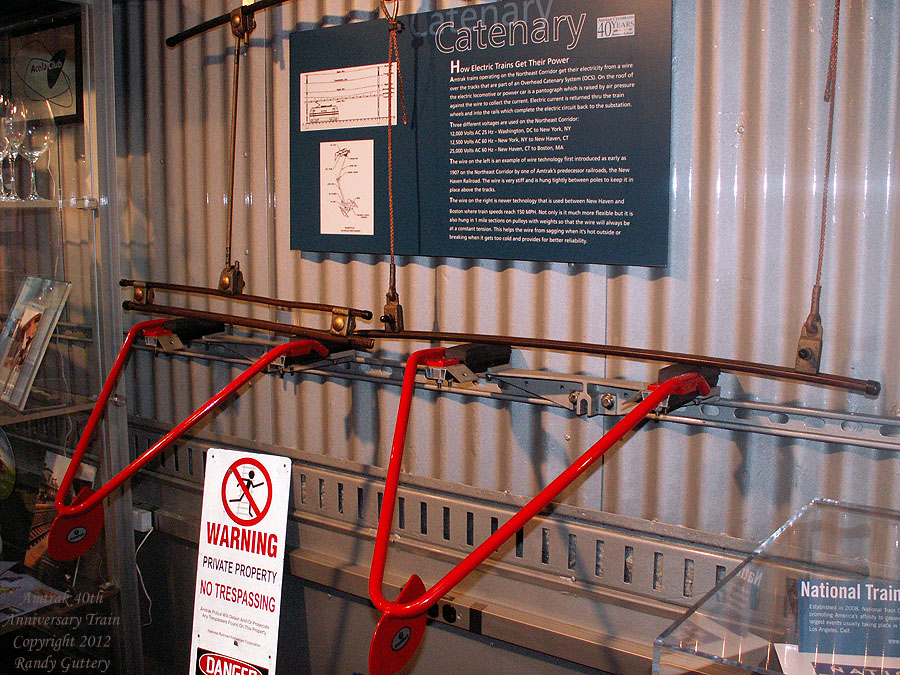 |
| All modern locomotives are electric. How they "power" their electric motos can be quite different - depending on where they operate. Most locomotives are diesel-electric - meaning they have onboard a high efficiency diesel powered generator that supplies power to the driving motors that turn the wheels. Not all locomotives are equipped that way - some depend power from fixed generating facilities - such as a local power company to supply the electric power they need. while the track can provide one power conductor (return path, if you will) the issue is how to get power to the (usually) moving locomotive. To be practical - a very high voltage is needed in order to transfer enough power to be practical for a full-sized train (there is a direct trade-off between voltage and current for a given amount of power - the lower the current (smaller wires, contacts, etc.) the higher the needed voltage to maintain a given power capacity. The problem with high voltage is that above certain levels - voltage can "jump" or arc across large distances of air - and even shorter distances of less able insulators. So using one rail to provide "power" isn't possible - since the rail being close to the ground - would allow the voltage to jump (arc) to ground. The solution, then - is to suspend a conductor (big wire, if you will) above the locomotive - and use a "pick-up" arrangement to transfer the high voltage. Such an arrangement is called a Catenary supply. "catenary" is the term used to refer to the natural "curve" of a wire, chain, etc. as it hangs between supports - so a catenary conductor is such a wire - supported over the tracks - and (pure) electric locomotives have a "pantograph" that keeps carbon (or other wearable contact material) contact blocks in contact with the overhead conductor. These are two examples of a conductor, catenary and pick-ups. |
|
|
| Work in Progress - check back soon! |
|
|
| Email: Randy and Sherry Guttery - Comcents.com |
|
|
| Glimpses of Meridian, Mississippi |
| Contents of this site are copyright © 2011 & 2012 Common Cents Computers. All rights reserved |